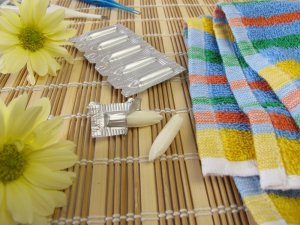Suppositories in Children: What You Should Know

Suppositories are a particular format of drugs. Because they’re somewhat uncomfortable to administer, they’re not the most common way to give drugs. Even so, doctors still recommend them in certain situations, especially with children. Here are some facts you should know about suppositories in children.
What are suppositories?
Suppositories are a particular format in drugs. They’re basically solid or semi-solid medicines that dissolve at room temperature. Because of this, they’re designed to be administered rectally, and you need to insert them into the body through the anus.

When are they used?
Not all medications are available in this format. Because of the discomfort they sometimes cause and their disadvantages, doctors usually limit their use to certain specific situations.
You can use suppositories in the case of localized problems, such as hemorrhoids. They can also be used for problems in other parts of the body. Their most widespread uses are in children with:
- Vomiting, which means that the child can’t take medicine orally, or brings up the medicine
- Difficulty in swallowing
- Emergency situations, such as seizures
- Fever
- Occasional constipation (the well-known glycerin suppository)
Applying suppositories in children
Each individual suppository is usually accompanied by the manufacturer’s instructions. Even so, there are usually a number of common steps to follow:
- Wash your hands before handling the suppository.
- The suppository should be hard. If it’s too soft, then store it in the refrigerator for half an hour or place it under cold water with the package tightly closed.
- Place the child on their side. The lower leg should be extended and the upper leg flexed toward the navel.
- Insert the suppository into the child’s anus, pressing gently with your finger, in the direction of the child’s navel. Contrary to popular belief, the suppository should be inserted with the flat side first rather than the sharp side. This will ensure that it’s inserted well and won’t come out easily.
- Once the suppository is in place, hold the child’s buttocks closed for a few seconds. Afterwards, the child will need to lie down for 10-15 minutes to give it time to be absorbed correctly and not expelled.

Precautions to take into account
Like any medication, the suppository has an expiry date. It’s important to check that it hasn’t expired before you use it.
Each manufacturer will indicate the measures to be taken for its conservation. Sometimes, it’s necessary to keep them in the refrigerator and other times it’s enough to keep them in a cool and dry place.
Finally, due to its peculiar application, it’s always important to use it with care so as not to harm the child. Of course, to ensure it works properly, we must give it time to work and make sure that the child doesn’t expel it from the anus.
In conclusion
Suppositories in children, although used less and less frequently, are still the most appropriate way to give medication in some cases, such as vomiting and seizures.
Given their peculiarities, it’s important to know how to store them and apply them correctly. Finally, it should be noted that the most reliable instructions will always be those given by the manufacturers of each particular suppository.
Suppositories are a particular format of drugs. Because they’re somewhat uncomfortable to administer, they’re not the most common way to give drugs. Even so, doctors still recommend them in certain situations, especially with children. Here are some facts you should know about suppositories in children.
What are suppositories?
Suppositories are a particular format in drugs. They’re basically solid or semi-solid medicines that dissolve at room temperature. Because of this, they’re designed to be administered rectally, and you need to insert them into the body through the anus.

When are they used?
Not all medications are available in this format. Because of the discomfort they sometimes cause and their disadvantages, doctors usually limit their use to certain specific situations.
You can use suppositories in the case of localized problems, such as hemorrhoids. They can also be used for problems in other parts of the body. Their most widespread uses are in children with:
- Vomiting, which means that the child can’t take medicine orally, or brings up the medicine
- Difficulty in swallowing
- Emergency situations, such as seizures
- Fever
- Occasional constipation (the well-known glycerin suppository)
Applying suppositories in children
Each individual suppository is usually accompanied by the manufacturer’s instructions. Even so, there are usually a number of common steps to follow:
- Wash your hands before handling the suppository.
- The suppository should be hard. If it’s too soft, then store it in the refrigerator for half an hour or place it under cold water with the package tightly closed.
- Place the child on their side. The lower leg should be extended and the upper leg flexed toward the navel.
- Insert the suppository into the child’s anus, pressing gently with your finger, in the direction of the child’s navel. Contrary to popular belief, the suppository should be inserted with the flat side first rather than the sharp side. This will ensure that it’s inserted well and won’t come out easily.
- Once the suppository is in place, hold the child’s buttocks closed for a few seconds. Afterwards, the child will need to lie down for 10-15 minutes to give it time to be absorbed correctly and not expelled.

Precautions to take into account
Like any medication, the suppository has an expiry date. It’s important to check that it hasn’t expired before you use it.
Each manufacturer will indicate the measures to be taken for its conservation. Sometimes, it’s necessary to keep them in the refrigerator and other times it’s enough to keep them in a cool and dry place.
Finally, due to its peculiar application, it’s always important to use it with care so as not to harm the child. Of course, to ensure it works properly, we must give it time to work and make sure that the child doesn’t expel it from the anus.
In conclusion
Suppositories in children, although used less and less frequently, are still the most appropriate way to give medication in some cases, such as vomiting and seizures.
Given their peculiarities, it’s important to know how to store them and apply them correctly. Finally, it should be noted that the most reliable instructions will always be those given by the manufacturers of each particular suppository.
All cited sources were thoroughly reviewed by our team to ensure their quality, reliability, currency, and validity. The bibliography of this article was considered reliable and of academic or scientific accuracy.
- Supositorios | EnFamilia. (n.d.). Retrieved February 17, 2020, from https://enfamilia.aeped.es/temas-salud/supositorios
- Los supositorios en niños: todo lo que hay que saber – Criar con Sentido Común. (n.d.). Retrieved February 17, 2020, from https://www.criarconsentidocomun.com/los-supositorios-en-ninos-todo-lo-que-hay-que-saber/
- Instrucciones para la administración de supositorios. (n.d.). Retrieved February 17, 2020, from https://www.aboutkidshealth.ca/Article?contentid=992&language=Spanish
This text is provided for informational purposes only and does not replace consultation with a professional. If in doubt, consult your specialist.








